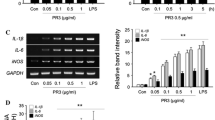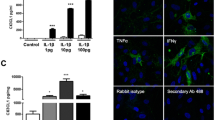Abstract
Microglia are the immune cells of the CNS. Brain injury triggers phenotypic changes in microglia including regulation of surface antigens. The serine proteinase α-thrombin can induce profound changes in neural cell physiology via cleavage of proteinase-activated receptors (PARs). We recently demonstrated that pharmaceutical-grade recombinant human α-thrombin (rh-thr) induces a restricted set of proteolysis-dependent changes in microglia. CD95(Fas) is a cell-death receptor that is up-regulated in microglia by inflammatory stimuli. Here we characterized the effect of rh-thr on CD95(Fas) expression in the N9 microglial cell line. Dose–response and time course studies demonstrated maximal effects at 100 U/ml and 24 h, respectively. Regulation of expression was seen at both the surface protein and steady-state mRNA levels. The rh-thr-induced effects were mimicked by PAR1 agonist peptides and blocked by pharmacologic inhibitors selective for extracellular signal-regulated kinase 1/2 (ERK 1/2). Rh-thr also induced a rapid and sustained phosphorylation of ERK 1/2. Thrombin-induced regulation of CD95(Fas) could modulate the neuroinflammatory response in a variety of neurological disorders.





Similar content being viewed by others
Abbreviations
- CNS:
-
Central nervous system
- PAR:
-
Proteinase-activated receptor
- rh-thr:
-
Pharmaceutical-grade recombinant human thrombin
- ERK 1/2:
-
Extracellular signal-regulated kinase 1/2
- JNK:
-
c-Jun activated kinase
- TNF:
-
Tumor necrosis factor
- LPS:
-
Lipopolysaccharide/endotoxin
- PMX:
-
Polymyxin B sulfate
- DMEM:
-
Dulbecco’s modified Eagle’s Medium
- FBS:
-
Fetal bovine serum
- MSFM:
-
Macrophage serum-free medium
- PBS:
-
Phosphate buffered saline
- EDTA:
-
Ethylenediaminetetraacetic acid
- Ig:
-
Immunoglobulin
- MAPK:
-
Mitogen-activated protein kinase
- HPRT:
-
Hypoxanthine phosphoribosyltransferase
References
Hanisch UK, Kettenmann H (2007) Microglia: active sensor and versatile effector cells in the normal and pathologic brain. Nat Neurosci 10:1387–1394. doi:10.1038/nn1997
Kreutzberg GW (1996) Microglia: a sensor for pathological events in the CNS. Trends Neurosci 19:312–318. doi:10.1016/0166-2236(96)10049-7
Davalos D, Grutzendler J, Yang G et al (2005) ATP mediates rapid microglial response to local brain injury in vivo. Nat Neurosci 8:752–758. doi:10.1038/nn1472
Nimmerjahn A, Kirchhoff F, Helmchen F (2005) Resting microglial cells are highly dynamic surveillants of brain parenchyma in vivo. Science 308:1314–1318. doi:10.1126/science.1110647
Melchior B, Puntambekar SS, Carson MJ (2006) Microglia and the control of autoreactive T cell responses. Neurochem Int 49:145–153. doi:10.1016/j.neuint.2006.04.002
Schwartz M, Butovsky O, Bruck W et al (2006) Microglial phenotype: is the commitment reversible? Trends Neurosci 29:68–74. doi:10.1016/j.tins.2005.12.005
Streit WJ (2002) Microglia as neuroprotective, immunocompetent cells of the CNS. Glia 40:133–139. doi:10.1002/glia.10154
Janeway CA, Travers P, Walport M et al (2005) T-cell mediated immunity. In: Lawrence E (ed) Immunobiology: the immune system in health and disease, 6th edn. Garland Science Publishing, New York, pp 346–355
Choi C, Benveniste EN (2004) Fas ligand/Fas system in the brain: regulator of immune and apoptotic responses. Brain Res Brain Res Rev 44:65–81. doi:10.1016/j.brainresrev.2003.08.007
Badie B, Schartner J, Prabakaran S et al (2001) Expression of Fas ligand by microglia: possible role in glioma immune evasion. J Neuroimmunol 120:19–24. doi:10.1016/S0165-5728(01)00361-7
Martin-Villalba A, Herr I, Jeremias I et al (1999) CD95 ligand (Fas-L/APO-1L) and tumor necrosis factor-related apoptosis-inducing ligand mediate ischemia-induced apoptosis in neurons. J Neurosci 19:3809–3817
Zipp F, Krammer PH, Weller M (1999) Immune (dys)regulation in multiple sclerosis: role of the CD95-CD95 ligand system. Immunol Today 20:550–554. doi:10.1016/S0167-5699(99)01545-5
Davie EW, Kulman JD (2006) An overview of the structure and function of thrombin. Semin Thromb Hemost 32(Suppl 1):3–15. doi:10.1055/s-2006-939550
Hanisch U-K, van Rossum D, Xie Y et al (2004) The microglia-activating potential of thrombin: the protease is not involved in the induction of proinflammatory cytokines and chemokines. J Biol Chem 279:51880–51887. doi:10.1074/jbc.M408318200
Weinstein JR, Hong S, Kulman JD et al (2005) Unraveling thrombin’s true microglia-activating potential: markedly disparate profiles of pharmaceutical-grade and commercial-grade thrombin preparations. J Neurochem 95:1177–1187. doi:10.1111/j.1471-4159.2005.03499.x
Weinstein JR, Swarts S, Bishop C et al (2008) Lipopolysaccharide is a frequent and significant contaminant in microglia-activating factors. Glia 56:16–26. doi:10.1002/glia.20585
Righi M, Letari O, Sacerdote P et al (1995) myc-immortalized microglial cells express a functional platelet- activating factor receptor. J Neurochem 64:121–129
Corradin SB, Mauel J, Donini SD et al (1993) Inducible nitric oxide synthase activity of cloned murine microglial cells. Glia 7:255–262. doi:10.1002/glia.440070309
Lee SJ, Zhou T, Choi C et al (2000) Differential regulation and function of Fas expression on glial cells. J Immunol 164:1277–1285
Grand RJ, Turnell AS, Grabham PW (1996) Cellular consequences of thrombin-receptor activation. Biochem J 313:353–368
Hollenberg MD, Compton SJ (2002) International union of pharmacology XXVIII. Proteinase-activated receptors. Pharmacol Rev 54:203–217. doi:10.1124/pr.54.2.203
Steinhoff M, Buddenkotte J, Shpacovitch V et al (2005) Proteinase-activated receptors: transducers of proteinase-mediated signaling in inflammation and immune response. Endocr Rev 26:1–43
Koistinaho M, Koistinaho J (2002) Role of p38 and p44/42 mitogen-activated protein kinases in microglia. Glia 40:175–183. doi:10.1002/glia.10151
Möller T, Weinstein JR, Hanisch UK (2006) Activation of microglial cells by thrombin: past, present, and future. Semin Thromb Hemost 32(Suppl 1):69–76. doi:10.1055/s-2006-939556
http://ca.expasy.org/tools/ EPt, Swiss-Prot Protein knowledgebase TrEMBL Computer-annotated supplement to Swiss-Prot
Walker WS, Gatewood J, Olivas E et al (1995) Mouse microglial cell lines differing in constitutive and interferon-gamma-inducible antigen-presenting activities for naive and memory CD4+ and CD8+ T cells. J Neuroimmunol 63:163–174. doi:10.1016/0165-5728(95)00146-8
Suo Z, Wu M, Ameenuddin S et al (2002) Participation of protease-activated receptor-1 in thrombin-induced microglial activation. J Neurochem 80:655–666. doi:10.1046/j.0022-3042.2001.00745.x
Suo Z, Wu M, Citron BA et al (2003) Persistent protease-activated receptor 4 signaling mediates thrombin-induced microglial activation. J Biol Chem 278:31177–31183. doi:10.1074/jbc.M302137200
Choi SH, Joe EH, Kim SU et al (2003) Thrombin-induced microglial activation produces degeneration of nigral dopaminergic neurons in vivo. J Neurosci 23:5877–5886
Lee DY, Oh YJ, Jin BK (2005) Thrombin-activated microglia contribute to death of dopaminergic neurons in rat mesencephalic cultures: dual roles of mitogen-activated protein kinase signaling pathways. Glia 51:98–110. doi:10.1002/glia.20190
Xi G, Reiser G, Keep RF (2003) The role of thrombin and thrombin receptors in ischemic, hemorrhagic and traumatic brain injury: deleterious or protective? J Neurochem 84:3–9. doi:10.1046/j.1471-4159.2003.01268.x
Ohnishi M, Katsuki H, Fujimoto S et al (2007) Involvement of thrombin and mitogen-activated protein kinase pathways in hemorrhagic brain injury. Exp Neurol 206:43–52. doi:10.1016/j.expneurol.2007.03.030
Acknowledgements
This work was supported by NIH/NINDS grants NS44337 (TM) and NS047309 (JRW). The authors thank ZymoGenetics, Inc., Seattle, WA, USA for the generous gift of pharmaceutical-grade recombinant human α-thrombin.
Author information
Authors and Affiliations
Corresponding author
Rights and permissions
About this article
Cite this article
Weinstein, J.R., Zhang, M., Kutlubaev, M. et al. Thrombin-Induced Regulation of CD95(Fas) Expression in the N9 Microglial Cell Line: Evidence for Involvement of Proteinase-Activated Receptor1 and Extracellular Signal-Regulated Kinase 1/2. Neurochem Res 34, 445–452 (2009). https://doi.org/10.1007/s11064-008-9803-9
Received:
Accepted:
Published:
Issue Date:
DOI: https://doi.org/10.1007/s11064-008-9803-9




